Blog
What Are Risk Factors for Athlete’s Foot?
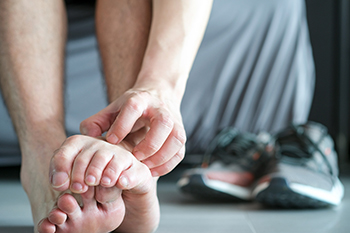
Athlete’s foot is a pesky affliction of the foot that you may experience at some point in your life. The condition is a kind of fungal infection that is spread in warm, moist environments. Most typically, athlete’s foot can be spread to someone when they walk barefoot in highly-trafficked public areas where the fungus is present such as pool sides and locker rooms. There are several risk factors associated with athlete’s foot. First, if you are someone who usually wears damp or tight-fitting shoes, socks, or stockings, then you are increasing your risk of developing athlete’s foot. Wearing this kind of shoe or sock for prolonged periods can essentially trap the fungus, enabling it to thrive and wreak havoc on your feet. Additionally, if you are someone who suffers from persistently sweaty feet, then you may be at a greater risk of developing athlete’s foot. Those with conditions such as HIV-AIDS who have impaired immune systems are also particularly susceptible to suffering from athlete’s foot, as such individuals have a difficult time fighting off the fungus. If you identify with any of these risk factor groups, it might be a good idea to contact a podiatrist who can help ward off athlete’s foot.
Athlete’s foot is an inconvenient condition that can be easily reduced with the proper treatment. If you have any concerns about your feet and ankles, contact Elliot T. Udell, DPM from New York. Our doctor will treat your foot and ankle needs.
Athlete’s Foot: The Sole Story
Athlete's foot, also known as tinea pedis, can be an extremely contagious foot infection. It is commonly contracted in public changing areas and bathrooms, dormitory style living quarters, around locker rooms and public swimming pools, or anywhere your feet often come into contact with other people.
Solutions to Combat Athlete’s Foot
- Hydrate your feet by using lotion
- Exfoliate
- Buff off nails
- Use of anti-fungal products
- Examine your feet and visit your doctor if any suspicious blisters or cuts develop
Athlete’s foot can cause many irritating symptoms such as dry and flaking skin, itching, and redness. Some more severe symptoms can include bleeding and cracked skin, intense itching and burning, and even pain when walking. In the worst cases, Athlete’s foot can cause blistering as well. Speak to your podiatrist for a better understanding of the different causes of Athlete’s foot, as well as help in determining which treatment options are best for you.
If you have any questions please feel free to contact our office located in Hicksville, NY . We offer the newest diagnostic and treatment technologies for all your foot and ankle needs.
Surgery for Ingrown Toenails

Ingrown toenails are unattractive and potentially uncomfortable foot ailments that primarily affect the big toenail. They occur when the side of the nail essentially grows into the skin of the toe. As a result, the affected area can swell, turn red, and become inflamed. There are many cases of ingrown toenails that, if caught early enough, can be treated and taken care of at home. Other cases can be addressed by a podiatrist with antibiotics or a splint and will not require surgery. However, if a case is severe enough and the ingrown toenail has become infected, then a surgery might be necessary to remedy the situation. There are a number of surgical procedures a doctor may perform. First, a doctor may perform a wedge resection (also known as a partial nail avulsion), in which a portion of the toenail causing the problem is removed. A doctor may also perform a toenail removal (or a complete nail plate avulsion) where the entire affected nail is removed. The intention behind this procedure is that the new nail will grow back correctly in 18 months. Of course, each patient’s potential to benefit from surgery for an ingrown toenail is highly individualized. As a standard rule of thumb, you can always consult with your podiatrist to determine the best treatment plan for your ingrown toenail.
Ingrown toenails can become painful if they are not treated properly. For more information about ingrown toenails, contact Elliot T. Udell, DPM of New York. Our doctor can provide the care you need to keep you pain-free and on your feet.
Ingrown Toenails
Ingrown toenails occur when a toenail grows sideways into the bed of the nail, causing pain, swelling, and possibly infection.
Causes
- Bacterial infections
- Improper nail cutting such as cutting it too short or not straight across
- Trauma to the toe, such as stubbing, which causes the nail to grow back irregularly
- Ill-fitting shoes that bunch the toes too close together
- Genetic predisposition
Prevention
Because ingrown toenails are not something found outside of shoe-wearing cultures, going barefoot as often as possible will decrease the likeliness of developing ingrown toenails. Wearing proper fitting shoes and using proper cutting techniques will also help decrease your risk of developing ingrown toenails.
Treatment
Ingrown toenails are a very treatable foot condition. In minor cases, soaking the affected area in salt or antibacterial soaps will not only help with the ingrown nail itself, but also help prevent any infections from occurring. In more severe cases, surgery is an option. In either case, speaking to your podiatrist about this condition will help you get a better understanding of specific treatment options that are right for you.
If you have any questions please feel free to contact our office located in Hicksville, NY . We offer the newest diagnostic and treatment technologies for all your foot and ankle needs.
All About Fractures to the Little Toe
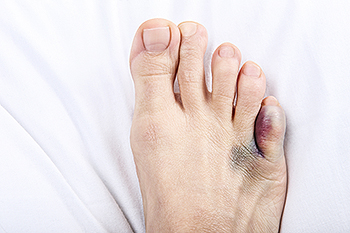
Fractures to the 5th metatarsal, or the pinky toe, are quite common. When the fracture occurs in the middle section of the metatarsal, it is known as a Jones fracture. The main cause is sudden force on the outside of the foot. A Jones fracture is common to athletes, dancers, and workers who stand for long periods. Men around 30, who are physically active, and women over 70, who may have osteoporosis, are more likely to sustain a Jones fracture as well. Symptoms include pain, swelling, tenderness, and difficulty walking. Check for discoloration or a bump on the side of the foot that is not usually there. It is not always easy to detect a Jones fracture through an X-ray, and in many cases an MRI or other imaging test may be required. As Jones fractures typically do not heal rapidly, it might take months before you can resume normal activities. If you believe you have sustained a Jones fracture, it’s a good idea to see a podiatrist as soon as possible for an exam and diagnosis.
A broken toe can be very painful and lead to complications if not properly fixed. If you have any concerns about your feet, contact Elliot T. Udell, DPM from New York. Our doctor will treat your foot and ankle needs.
What to Know About a Broken Toe
Although most people try to avoid foot trauma such as banging, stubbing, or dropping heavy objects on their feet, the unfortunate fact is that it is a common occurrence. Given the fact that toes are positioned in front of the feet, they typically sustain the brunt of such trauma. When trauma occurs to a toe, the result can be a painful break (fracture).
Symptoms of a Broken Toe
- Throbbing pain
- Swelling
- Bruising on the skin and toenail
- The inability to move the toe
- Toe appears crooked or disfigured
- Tingling or numbness in the toe
Generally, it is best to stay off of the injured toe with the affected foot elevated.
Severe toe fractures may be treated with a splint, cast, and in some cases, minor surgery. Due to its position and the pressure it endures with daily activity, future complications can occur if the big toe is not properly treated.
If you have any questions please feel free to contact our office located in Hicksville, NY . We offer the newest diagnostic and treatment technologies for all your foot and ankle needs.
Plantar Warts Can Be Treated!
What to Expect in Your Feet When You’re Expecting

When a woman is pregnant, she experiences many different physical changes that can affect all parts of her body. The woman’s foot is one such body part that can be affected. A woman may experience general pain and discomfort in her feet, or even conditions such as plantar fasciitis, during her pregnancy. This is because as the baby grows inside the woman, she carries more weight when she walks, which can lead to pain. A woman’s feet will also become swollen, especially during the third trimester of her pregnancy, because she experiences an increase of bodily fluids and blood volume. Hormonal changes may also contribute to swollen feet during pregnancy. To mitigate swollen feet, a pregnant woman may try to drink a significant amount of water and encourage healthy blood circulation to the feet by avoiding crossing her legs or ankles when sitting. Pregnancy is undoubtedly an exciting yet stressful time for a woman. To get a better understanding of how your pregnancy might be affecting your feet, it is suggested that you consult with a podiatrist.
Pregnant women with swollen feet can be treated with a variety of different methods that are readily available. For more information about other cures for swollen feet during pregnancy, consult with Elliot T. Udell, DPM from New York. Our doctor will attend to all of your foot and ankle needs.
What Foot Problems Can Arise During Pregnancy?
One problem that can occur is overpronation, which occurs when the arch of the foot flattens and tends to roll inward. This can cause pain and discomfort in your heels while you’re walking or even just standing up, trying to support your baby.
Another problem is edema, or swelling in the extremities. This often affects the feet during pregnancy but tends to occur in the later stages.
How Can I Keep My Feet Healthy During Pregnancy?
- Wearing orthotics can provide extra support for the feet and help distribute weight evenly
- Minimize the amount of time spent walking barefoot
- Wear shoes with good arch support
- Wear shoes that allow for good circulation to the feet
- Elevate feet if you experience swelling
- Massage your feet
- Get regular, light exercise, such as walking, to promote blood circulation to the feet
If you have any questions please feel free to contact our office located in Hicksville, NY . We offer the newest diagnostic and treatment technologies for all your foot and ankle needs.
What Is Chronic Ankle Instability?

The ankle is commonly injured during athletic activities, and ankle sprains account for a large percentage of sports injuries. Ankle sprains can occur in many service members and non-athletes as well. It is important to seek professional treatment for an ankle sprain, because an improperly healed ankle sprain may make recurrent ankle sprains more likely, which can lead to chronic ankle instability. If the ligament(s) that have been overly stretched in an ankle sprain remain loose, this is typically indicative of mechanical ankle instability. Functional ankle instability may be associated with weakness in the muscles, and deficits in the nervous and neuromuscular systems. If you have suffered one or more ankle sprains and your ankle feels painful, stiff, weak or wobbly, or gives out when standing or walking, it is wise to consult a podiatrist. They will perform a physical examination and may conduct imaging tests to diagnose chronic ankle instability and begin an appropriate treatment program.
Ankle pain can have many different causes and the pain may potentially be serious. If you have ankle pain, consult with Elliot T. Udell, DPM from New York. Our doctor will assess your condition and provide you with quality foot and ankle treatment.
Ankle pain is any condition that causes pain in the ankle. Due to the fact that the ankle consists of tendons, muscles, bones, and ligaments, ankle pain can come from a number of different conditions.
Causes
The most common causes of ankle pain include:
- Types of arthritis (rheumatoid, osteoarthritis, and gout)
- Ankle sprains
- Broken ankles
- Achilles tendinitis
- Achilles tendon rupture
- Stress fractures
- Tarsal tunnel syndrome
- Plantar fasciitis
Symptoms
Symptoms of ankle injury vary based upon the condition. Pain may include general pain and discomfort, swelling, aching, redness, bruising, burning or stabbing sensations, and/or loss of sensation.
Diagnosis
Due to the wide variety of potential causes of ankle pain, podiatrists will utilize a number of different methods to properly diagnose ankle pain. This can include asking for personal and family medical histories and of any recent injuries. Further diagnosis may include sensation tests, a physical examination, and potentially x-rays or other imaging tests.
Treatment
Just as the range of causes varies widely, so do treatments. Some more common treatments are rest, ice packs, keeping pressure off the foot, orthotics and braces, medication for inflammation and pain, and surgery.
If you have any questions, please feel free to contact our office located in Hicksville, NY . We offer the newest diagnostic and treatment technologies for all your foot care needs.
Flat Foot Exercises
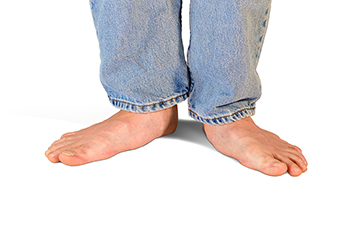
Fallen arches are another name for flat feet. It is noticed while standing and the entire foot lies flat on the ground. Many people have genetic traits for this condition and some people experience discomfort with it. The arch plays a crucial role in maintaining balance in the body and may be improved by performing specific exercises. A towel scrunch is done by sitting on a chair and putting a towel on the floor by your feet. This is followed by grabbing the towel with the muscles in the feet. This is repeated several times and completed with the other foot too. An effective foot and arch stretch is referred to as stair heel raises. This is accomplished by standing on a step and lowering the heel until a gentle stretch is felt. A toe extension can benefit the muscles in the top of the foot that helps to control the toes. This is achieved by pushing on the toes with the fingers and holding for several seconds. If you would like to know more information about flat foot exercises, please confer with a podiatrist.
Flatfoot is a condition many people suffer from. If you have flat feet, contact Elliot T. Udell, DPM from New York. Our doctor will treat your foot and ankle needs.
What Are Flat Feet?
Flatfoot is a condition in which the arch of the foot is depressed and the sole of the foot is almost completely in contact with the ground. About 20-30% of the population generally has flat feet because their arches never formed during growth.
Conditions & Problems:
Having flat feet makes it difficult to run or walk because of the stress placed on the ankles.
Alignment – The general alignment of your legs can be disrupted, because the ankles move inward which can cause major discomfort.
Knees – If you have complications with your knees, flat feet can be a contributor to arthritis in that area.
Symptoms
- Pain around the heel or arch area
- Trouble standing on the tip toe
- Swelling around the inside of the ankle
- Flat look to one or both feet
- Having your shoes feel uneven when worn
Treatment
If you are experiencing pain and stress on the foot you may weaken the posterior tibial tendon, which runs around the inside of the ankle.
If you have any questions please feel free to contact our office located in Hicksville, NY . We offer the newest diagnostic and treatment technologies for all your foot and ankle needs.
Self Care in Elderly Patients
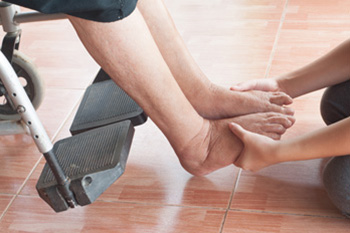
Self care may decrease with elderly patients. This can be a result of having poor circulation, and it may be difficult to wash and dry the feet. Research has indicated that chronic medical conditions may increase in elderly patients, and this can make it difficult to practice proper foot care. There have been studies that have found improvements in blood circulation, walking ability, and muscle fatigue when good foot care is frequently performed. Flexibility and range of motion may be improved when specific foot stretches are performed. These can include pointing and flexing each foot, followed by moving them from right to left. It is beneficial to inspect the bottom of the feet for existing cuts, bruises, or sores that may have developed. This can be done by having a family member help, or by using a mirror. The feet will feel good and can positively affect the overall body when comfortable shoes are worn. If you have an elderly parent or friend that needs more information about how to properly care for their feet, please help them by scheduling an appointment with a podiatrist.
Proper foot care is something many older adults forget to consider. If you have any concerns about your feet and ankles, contact Elliot T. Udell, DPM from New York. Our doctor can provide the care you need to keep you pain-free and on your feet.
The Elderly and Their Feet
As we age we start to notice many changes in our body, but the elder population may not notice them right away. Medical conditions may prevent the elderly to take notice of their foot health right away. Poor vision is a lead contributor to not taking action for the elderly.
Common Conditions
- Neuropathy – can reduce feeling in the feet and can hide many life-threatening medical conditions.
- Reduced flexibility – prevents the ability of proper toenail trimming, and foot cleaning. If left untreated, it may lead to further medical issues.
- Foot sores – amongst the older population can be serious before they are discovered. Some of the problematic conditions they may face are:
- Gouging toenails affecting nearby toe
- Shoes that don’t fit properly
- Pressure sores
- Loss of circulation in legs & feet
- Edema & swelling of feet and ankles
Susceptible Infections
Diabetes and poor circulation can cause general loss of sensitivity over the years, turning a simple cut into a serious issue.
If you have any questions please feel free to contact our office located in Hicksville, NY . We offer the newest diagnostic and treatment technologies for all your foot and ankle needs.
Sports Injuries in Dancers

There are a variety of factors that can contribute to a dancer injuring their feet or ankles. Some factors are things the dancer cannot control, such as body type, age, the shape of feet and ankles, existing medical conditions or prior injuries, and the type of dance and surface they are dancing on. Other factors that can be avoided and are within the dancer’s control include not warming up/stretching/cooling down properly, wearing improper footwear, not staying hydrated or eating properly, and not building up the frequency or duration of performances and/or practices gradually. Dancing injuries can also occur if the dancer is attempting moves that are beyond their skill or ability at the time of injury. Any type of foot or ankle injury that a dancer suffers should be examined by a podiatrist as soon as possible. Trying to “muscle through” an injury that needs professional treatment can lead to further injury and may even prevent the dancer from being able to dance if the injury does not heal properly. Every dancer is different, and every injury is different. A podiatrist will create a custom treatment plan after thoroughly examining the dancer’s injury.
Sports related foot and ankle injuries require proper treatment before players can go back to their regular routines. For more information, contact Elliot T. Udell, DPM of New York. Our doctor can provide the care you need to keep you pain-free and on your feet.
Sports Related Foot and Ankle Injuries
Foot and ankle injuries are a common occurrence when it comes to athletes of any sport. While many athletes dismiss the initial aches and pains, the truth is that ignoring potential foot and ankle injuries can lead to serious problems. As athletes continue to place pressure and strain the area further, a mild injury can turn into something as serious as a rupture and may lead to a permanent disability. There are many factors that contribute to sports related foot and ankle injuries, which include failure to warm up properly, not providing support or wearing bad footwear. Common injuries and conditions athletes face, including:
- Plantar Fasciitis
- Plantar Fasciosis
- Achilles Tendinitis
- Achilles Tendon Rupture
- Ankle Sprains
Sports related injuries are commonly treated using the RICE method. This includes rest, applying ice to the injured area, compression and elevating the ankle. More serious sprains and injuries may require surgery, which could include arthroscopic and reconstructive surgery. Rehabilitation and therapy may also be required in order to get any recovering athlete to become fully functional again. Any unusual aches and pains an athlete sustains must be evaluated by a licensed, reputable medical professional.
If you have any questions please feel free to contact our office located in Hicksville, NY . We offer the newest diagnostic and treatment technologies for all your foot and ankle needs.
Arthritis Can Cause Pain in the Feet and Ankles
More...
Being Properly Fitted for Walking Shoes

When it comes to finding the right walking shoe, you want to start by being properly fitted. Stores that specialize in athletic shoes will most likely have professional staff on hand to properly measure your feet and work with you as you are trying shoes on to ensure a proper fit. Make sure you try shoes on wearing the same socks that you will wear once you start using the shoes. Make sure the shoes feel great in the store, and do not assume that they will feel better once you “break them in” at home. Do not buy any shoe that has areas that rub against your feet. A podiatrist can also measure your feet and offer professional advice on the type of running shoe that is most appropriate for your particular feet. They can also create custom orthotics to address any gait abnormalities or structural issues your feet may have.
Getting the right shoe size is an important part of proper foot health. Seek the assistance of Elliot T. Udell, DPM from New York. Our doctor will provide the care you need to keep you pain-free and on your feet.
Getting the Right Shoe Size
There are many people who wear shoes that are the incorrect size, negatively affecting their feet and posture. Selecting the right shoes is not a difficult process, so long as you keep several things in mind when it comes to choosing the right pair.
- When visiting the shoe store, use the tools available to measure your foot.
- Be sure there is ‘wiggle room’. There should be about an inch between your toes and the tip of your shoes.
- Do not always assume you are the same size, as manufacturers run differently.
- Purchase shoes later in the day, as your feet swell as the day progresses.
- If a shoe is not comfortable, it is not suitable. Most shoes can’t be ‘broken in’, and comfort should be the ultimate goal when it comes to choosing the right pair of shoes
As our feet hold our body weight and keep us moving, it is important to treat them right. Picking the right pair of shoes can provide your feet comfort and mobility without pain.
If you have any questions, please feel free to contact our office located in Hicksville, NY . We offer the newest diagnostic and treatment technologies for all your foot care needs.
Relief for Sore Feet
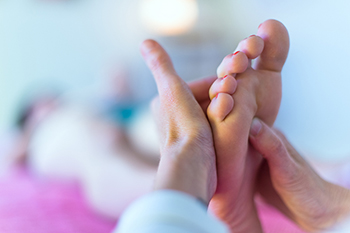
We all have sore feet from time to time. After all, our feet do a lot of work for us and put in long hours. There are a variety of ways to soothe sore feet at home. Generally, using a combination of treatments work best to revitalize sore feet. Warm foot baths using Epsom salts can relieve swollen, painful feet. Stretching the toes and heels can aid with foot pain by increasing flexibility and preventing cramping. Foot pain can be avoided by strengthening and resistance exercises to help keep feet strong and limber. Orthotics or arch supports can help stabilize the feet and eliminate discomfort. Simple icing of aching feet can reduce inflammation that may be caused by soreness. Wearing night splints can help with keeping feet stretched properly to avoid or control foot pain. If you have painful, achy feet or tingling or numbness in your feet, a podiatrist should be consulted and treatment prescribed.
Foot therapy is often necessary for those recovering from either foot deformities or foot injuries. If you have concerns regarding therapy, consult with Elliot T. Udell, DPM from New York. Our doctor can provide the care you need to keep you pain-free and on your feet.
Most Common Injuries
People who are active or athletes are prone to a variety of injuries. Therefore, it is often important to take part in physical therapy in order to quickly get back on the right track.
What to Do When Injured
Physical Therapy – This specialized treatment will focus on the affected area, speeding up recovery and the overall healing process. It is a proven method that has helped millions of people return from any injury.
During physical therapy you will undergo regimented training to get back into full form. Training is often very difficult, especially at first when the foot feels weak. Physical therapy often involves:
Basic stretching and twisting exercises – getting the feet’s mobility and flexibility up.
Massaging – the therapist will massage the injured area in order to activate the muscles and relax them.
Strengthening Exercises – this allows the muscles in the affected area to regain their full strength, a vital step towards full recovery.
If you have any questions please feel free to contact our office located in Hicksville, NY . We offer the newest diagnostic tools and technology to treat your foot and ankle needs.
Sweaty Sock Syndrome in Children

Some children develop sweaty sock syndrome which is also known as juvenile plantar dermatosis. Symptoms can include redness and scaly skin on the bottom of the feet. This condition is commonly seen in boys who are 4-8 years old, but it has also affected children who range from 3 to 15 years old. Juvenile plantar dermatosis can become chronic, sometimes lasting for about 3 years, but it generally dissipates as the child reaches puberty. Going from moist to dry conditions is thought to contribute to sweaty sock syndrome, but the actual cause is not clear. It is commonly noticed on the big toe, ball of the foot, and the heel as those places bear the most weight. The skin appears red, shiny, and smooth, but sometimes develops cracks. Home remedies suggest wearing breathable shoes, avoiding plastic or rubber footwear, and moisturizing the feet at night with petroleum jelly. If your child’s condition persists or worsens, please consult with a podiatrist who can better evaluate the problem and offer further treatment options.
Making sure that your children maintain good foot health is very important as they grow. If you have any questions, contact Elliot T. Udell, DPM of New York. Our doctor can provide the care you need to keep you pain-free and on your feet.
Keeping Children's Feet Healthy
Having healthy feet during childhood can help prevent medical problems later in life, namely in the back and legs. As children grow, their feet require different types of care. Here are some things to consider...
Although babies do not walk yet, it is still very important to take care of their feet.
Avoid putting tight shoes or socks on his or her feet.
Allow the baby to stretch and kick his or her feet to feel comfortable.
As a toddler, kids are now on the move and begin to develop differently. At this age, toddlers are getting a feel for walking, so don’t be alarmed if your toddler is unsteady or ‘walks funny’.
As your child gets older, it is important to teach them how to take care of their feet.
Show them proper hygiene to prevent infections such as fungus.
Be watchful for any pain or injury.
Have all injuries checked by a doctor as soon as possible.
Comfortable, protective shoes should always be worn, especially at play.
If you have any questions please feel free to contact our office located in Hicksville, NY . We offer the newest diagnostic and treatment technologies for all your foot and ankle needs.
Everyday Foot Care May Help to Prevent Foot Conditions

Many people worldwide tend to neglect their feet. There are simple practices for everyday foot care that can provide comfort, softer skin, and a general feeling of wellbeing. These can include moisturizing frequently, wearing shoes that fit correctly, and trimming the toenails properly. There are specific foot conditions that may be prevented when the feet are properly taken care of. Athlete’s foot can possibly be avoided when appropriate shoes are worn in public areas. Bunions are less likely to develop when shoes that fit correctly are worn. A blister can cause discomfort, and generally forms as a result of excess friction that can come from shoes and socks that are too tight. Some people find it relaxing and soothing to pamper their feet in warm water, followed by having a foot massage. If you would like additional information about effective foot care techniques, please consult with a podiatrist.
Everyday foot care is very important to prevent infection and other foot ailments. If you need your feet checked, contact Elliot T. Udell, DPM from New York. Our doctor can provide the care you need to keep you pain-free and on your feet.
Everyday Foot Care
Often, people take care of their bodies, face and hair more so than they do for their feet. But the feet are a very important aspect of our bodies, and one that we should pay more attention to. Without our feet, we would not be able to perform most daily tasks.
It is best to check your feet regularly to make sure there are no new bruises or cuts that you may not have noticed before. For dry feet, moisturizer can easily be a remedy and can be applied as often as necessary to the affected areas. Wearing shoes that fit well can also help you maintain good foot health, as well as making it easier to walk and do daily activities without the stress or pain of ill-fitting shoes, high heels, or even flip flops. Wearing clean socks with closed shoes is important to ensure that sweat and bacteria do not accumulate within the shoe. Clean socks help to prevent Athlete’s foot, fungi problems, bad odors, and can absorb sweat.
If you have any questions please feel free to contact our office located in Hicksville, NY . We offer the newest diagnostic and treatment technologies for all your foot and ankle needs.


